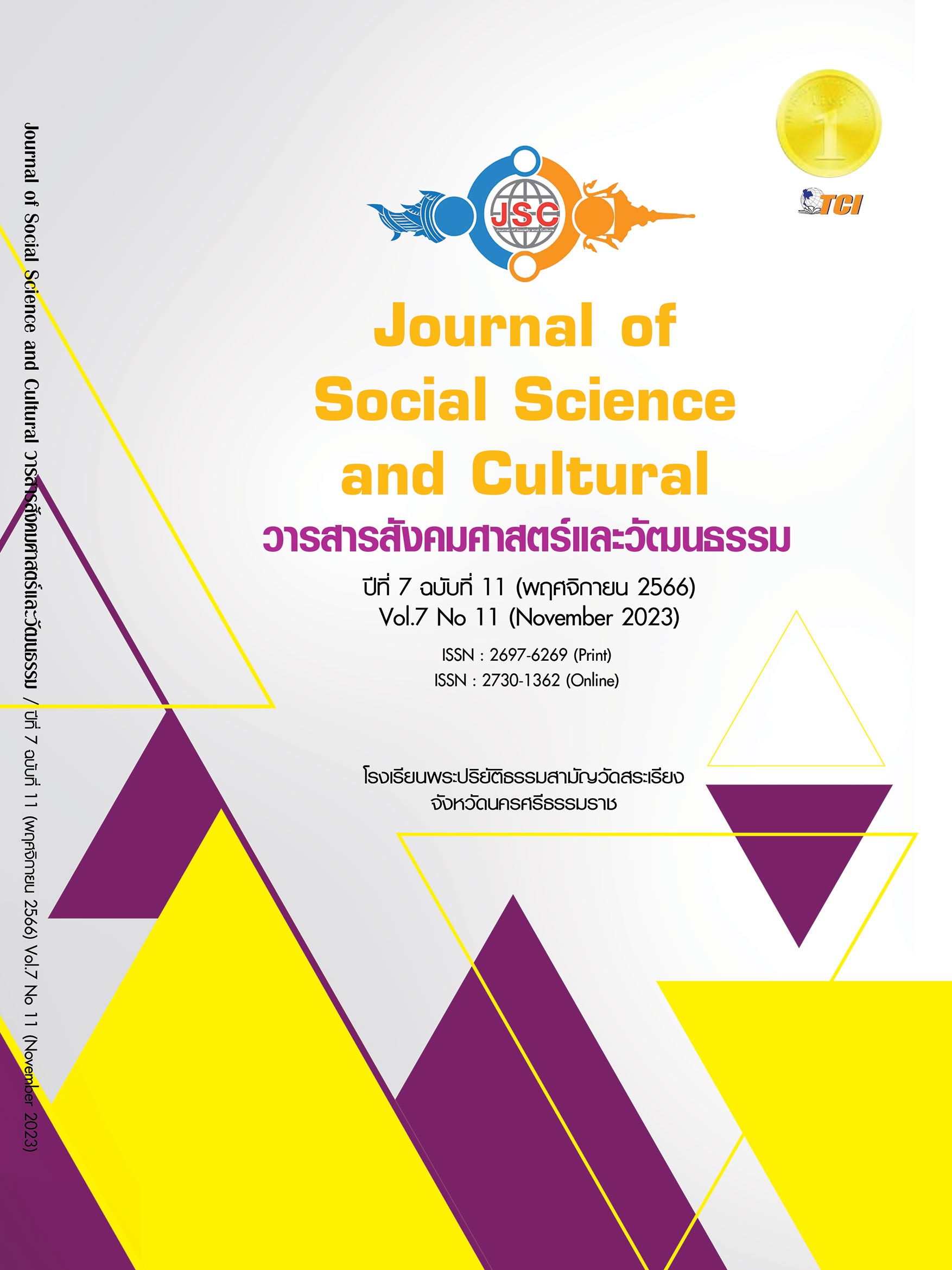SNORKELING GUIDELINES PRACTICES AROUND THE SAMAE SAN ISLANDS, CHONBURI PROVINCE
Main Article Content
Abstract
This article on good practices for snorkeling in the Samae San Islands area. Chonburi Province. The objectives are 1) to study operations in the areas of Koh Samae San and Koh Pla – muek, 2) to study good practices for snorkeling activities in the areas of Koh Samae San Koh Pla – muek, and 3) to determine good practices for snorkeling activities. Shallow water in the areas of Koh Samae San and Koh Pla – muek. This is a participatory action research carried out in 3 steps: Step 1) surveying the conditions regarding snorkeling activities at Koh Samae San and Koh Pla – muek, Step 2) surveying. Guidelines for snorkeling. Step 3) Creating guidelines for snorkeling activities in the Samae San Island area. The population is tourists who travel to Samae San Island. The sample group consisted of 205 tourists who came to snorkel at Koh Samae San and Koh Pla – muek and officers in charge of beach activities. Data collection used methods and tools to collect data, namely 1) a structured questionnaire with tourists, 2) an interview with staff of the Thai Island and Sea Science Museum. Data analysis used the Basic Social Science Statistics (SPSS) program to calculate percentages, means, and standard deviations with the interview results. The results of the study found that tourists are aware of the value of local natural resources. Have awareness of conservation and snorkeling management guidelines. The appropriate course of action is to provide conservation knowledge before diving. Practice using diving equipment until you are confident. Establishing a distance between tourists and coral and wearing a buoyancy vest while diving will reduce environmental damage relative to each other.
Article Details
References
กรมทรัพยากรทางทะเลและชายฝั่ง. (2562). แผนที่ปะการัง ปี 2562. กรุงเทพมหานคร: สถาบันวิจัยและพัฒนาทรัพยากรทางทะเล ชายฝั่งทะเล และป่าชายเลน.
กระทรวงการท่องเที่ยวและกีฬา. (2565). สถานการณ์การท่องเที่ยวในประเทศรายจังหวัด ปี 2566. เรียกใช้เมื่อ 14 ตุลาคม 2566 จาก https://www.mots.go.th/news/category/705
ฐานเศรษฐกิจ. (2566). สายดำน้ำ สะดุ้ง! ครม.เคาะกฎหมายคุมหวั่นทำลาย "ปะการัง" โทษถึงคุก. เรียกใช้เมื่อ 14 ตุลาคม 2566 จาก https://www.thansettakij.com/business/economy/574182
ณัฐภณ เกิดเลห์. (19 สิงหาคม 2566). แนวทางการจัดการการดำน้ำตื้นเกาะแสมสาร เกาะปลาหมึก. (อุจฉริต์ อาจาระศิริกุล, ผู้สัมภาษณ์)
เทวฤทธิ์ แก้วไซอินทร์. (25 สิงหาคม 2566). แนวทางการจัดการการดำน้ำตื้นเกาะแสมสาร เกาะปลาหมึก. (อุจฉริต์ อาจาระศิริกุล, ผู้สัมภาษณ์)
ธนภัทร ยอดเงิน. (25 สิงหาคม 2566). แนวทางการจัดการการดำน้ำตื้นเกาะแสมสาร เกาะปลาหมึก. (อุจฉริต์ อาจาระศิริกุล, ผู้สัมภาษณ์)
ธีรวุฒิ เอกะกุล. (2544). ระเบียบวิธีวิจัยทางพฤติกรรมศาสตร์และสังคมศาสตร์. (พิมพ์ครั้งที่ 2). อุบลราชธานี: วิทยาการพิมพ์.
บุญชม ศรีสะอาด และบุญส่ง นิลแก้ว. (2535). การอ้างอิงประชากรเมื่อใช้เครื่องมือแบบมาตราส่วน ประมาณค่ากับกลุ่มตัวอย่าง. การวัดผลการศึกษา มหาวิทยาลัยศรีนครินทรวิโรฒ มหาสารคาม, 3(1), 22-25.
วิภูษิต มัณฑะจิตร และคณะ. (2548). รายงานวิจัยฉบับสมบูรณ์ การสำรวจสภาพของปะการังในจังหวัดระยองเพื่อการท่องเที่ยวอย่างยั่งยืน. ได้รับการสนับสนุนการวิจัยจากสำนักงานคณะกรรมการอุดมศึกษา. ชลบุรี: ภาควิชาวาริชศาสตร์ คณะวิทยาศาสตร์ มหาวิทยาลัยบูรพา.
ศุภรินทร์ บุญโพธิ์. (19 สิงหาคม 2566). แนวทางการจัดการการดำน้ำตื้นเกาะแสมสาร เกาะปลาหมึก. (อุจฉริต์ อาจาระศิริกุล, ผู้สัมภาษณ์)
สมชาย วิเศษรัตน์. (27 สิงหาคม 2566). แนวทางการจัดการการดำน้ำตื้นเกาะแสมสาร เกาะปลาหมึก. (อุจฉริต์ อาจาระศิริกุล, ผู้สัมภาษณ์)
สายชล หนูแวว. (27 สิงหาคม 2566). แนวทางการจัดการการดำน้ำตื้นเกาะแสมสาร เกาะปลาหมึก. (อุจฉริต์ อาจาระศิริกุล, ผู้สัมภาษณ์)
สำนักงานสาธารณสุขจังหวัดชลบุรี. (2563). คำสั่ง คกก.โรคติดต่อ จ.ชลบุรี ที่ 11/2563 ลงวันที่ 3 เมษายน 2563. เรียกใช้เมื่อ 25 พฤศจิกายน 2566 จาก cbo.moph.go.th/cbo/index.php/post-formats/covid/covid-19?start=20.pdf
สำนักบริหารยุทธศาสตร์กลุ่มจังหวัดภาคตะวันออก 1. (2566). แผนพัฒนากลุ่มจังหวัดภาคตะวันออก 1 (พ.ศ.2566-2570) ฉบับทบทวนประจำปีงบประมาณ พ.ศ. 2567. ชลบุรี: กลุ่มงานบริหารยุทธศาสตร์กลุ่มจังหวัดภาคตะวันออก 1 (ชลบุรี).
สุวิมล ติรกานันท์. (2557). ระเบียบวิธีวิจัยทางสังคมศาสตร์.(พิมพ์ครั้งที่ 12). กรุงเทพมหานคร: โรงพิมพ์แห่งจุฬาลงกรณ์มหาวิทยาลัย.
หรรษา จันทร์แสง และคณะ . (2542). แผนที่แนวปะการังในน่านน้ำไทย เล่มที่ 1 อ่าวไทย. ภูเก็ต: โครงการจัดการทรัพยากรปะการัง กรมประมง.
อนันต์ เสนาะโสตร. (22 เมษายน 2566). กิจกรรมการท่องเที่ยวทางทะเล. (อุจฉริต์ อาจาระศิริกุล, ผู้สัมภาษณ์)
อลงกต สิทธิไชย. (19 สิงหาคม 2566). แนวทางการจัดการการดำน้ำตื้นเกาะแสมสาร เกาะปลาหมึก. (อุจฉริต์ อาจาระศิริกุล, ผู้สัมภาษณ์)
Briandana, R. et al. (2018). Promotion analysis of marine tourism In Indonesia : A case Study, European. Research Studies Journal, XXI(I), 602-613.
Chundhitisakul, A. (2017). Determining sample size with ready-made tables. Retrieved November 25, 2023, from https://www.mots.go.th/news/category/705
De, K. et al. (2020). Coral damage by recreational diving activities in a marine protected area of India: Unaccountability leading to ‘tragedy of the not so commons. Marine Pollution Bulletin, 155(1), 111190.
Dimas, R. T. & Gurning S. R. O. (2018). Development of marine and coastal tourism based on blue economy. International Journal of Engineering Innovation and Research, 2(2), 128-132.
Orams, M. (1999). Marine tourism : Development, impact and management. New York: Routledge.
Sangkhaduang, T. et al. (2023). Exploring Factors Influencing Tourists' Environmentally Responsible Behavior for Snorkeling Tourism, Thailand. International Journal of Sustaninable Development and Planing, 18(7), 2183-2190.
Wilks, J. (2000). Scuba diving and snorkeling safty on Australia’s Great barrier reef. Journal of Travel Medicine, 7(5), 283-289.


